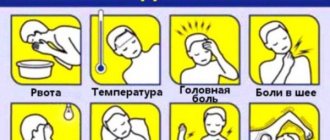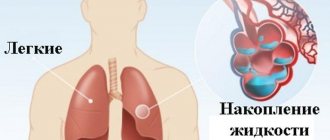Myasthenia gravis is a disease that is characterized by a violation of neuromuscular transmission (that is, a violation of the process of muscle contraction that occurs in response to an impulse traveling along a nerve fiber). The cause of myasthenia gravis is often an autoimmune process, as a result of which the body produces antibodies to the structures of the neuromuscular synapse. According to statistics, myasthenia gravis occurs in every 5 out of 100 thousand people. It is a chronic disease with acute or gradual onset. The main manifestation is transient muscle weakness; ptosis (drooping) of the upper eyelids, impaired swallowing, and a “nasal” voice may also occur. In severe cases and as the disease progresses, weakness of the respiratory muscles may occur, including respiratory arrest.
The dangerous disease progresses rapidly, clinical manifestations may subside and worsen again. Pathological muscle fatigue is diagnosed more often in women than in men, and much less often in children. The average age of patients is from 15 to 45 years, thus, the maximum number of cases is registered in the most active part of the population.
At CELT you can get advice from a neurologist.
- Initial consultation – 4,000
- Repeated consultation – 2,500
Make an appointment
About the reasons
Currently, the causes of myasthenia gravis are not fully understood. Sometimes it is impossible to say unambiguously why a particular patient developed a disease. It is generally accepted that the following factors play a significant role:
- Family predisposition. Very often it turns out that the diagnosis of myasthenia gravis has already been made to the patient’s close relatives.
- Frequent stress, disorders in the immune system, the harmful effects of viruses, bacteria and other microorganisms. These factors “shatter” the immune system, and the body begins to synthesize antibodies against its own tissues, in particular, against the receptor proteins of the postsynaptic membrane. This leads to a delay in the transmission of signals from nerves to muscles, even blocking impulses.
- Myasthenia gravis can be a consequence of certain diseases. For example, when the thymus gland (thymus) grows, antibodies to synapse receptors also begin to be produced.
When malignant neoplasms appear in the ovaries, respiratory organs or mammary glands, they speak of Lambert-Eaton myasthenic syndrome. Muscle weakness, sometimes mistaken for myasthenia gravis, occurs with Charcot-Marie disease, dermatomyositis (destruction of connective tissue), various forms of myopathies, ALS syndrome (amyotrophic lateral sclerosis) and many other pathologies.
Soft tissue MRI
- Cost: 6,000 rub.
More details
The difficulty of diagnosis is that patients with myasthenia gravis at the onset of the disease may not have any clear complaints and symptoms. Neuroimaging (or MRI) shows no significant abnormalities in the structures of the central nervous system. Only in 30% of patients the thymus becomes enlarged or neoplasms are detected in it. When examined, the muscles are also not changed in any way; pathology can only be detected by microscopic examination.
Read also
Rehabilitation
Restoration of the body after diseases of the central and peripheral nervous system, operations on the brain and spinal cord, conditions after removal of the mammary gland due to a tumor, consequences...
Read more
Clubfoot
Clubfoot should not be understood as just one foot disorder. This is a group of deformities of the foot and ankle joint with their pathological setting. Clubfoot is a deformity in which...
More details
Intracranial hypertension on MRI
Intracranial hypertension is an increase in intracranial pressure. Normal intracranial pressure is 15 mm Hg. When blood pressure doubles, a stroke occurs. At a pressure of 50 mm Hg, the patient can...
More details
Syringomyelia
Syringomyelia is a disease caused by the formation of spaces in the substance of the spinal cord filled with cerebrospinal fluid. They expand the spinal cord at the level of the lower cervical and thoracic regions...
More details
Consequences of traumatic injuries to the skull, spine, brain and spinal cord
Traumatic brain injuries, or traumatic brain injuries, are damage to the brain that impair brain function. Brain injuries are divided into two large groups - closed...
More details
Classification
Forms of myasthenia:
- congenital
- acquired
Congenital myasthenia gravis can be caused by genetic mutations. The fetus can also receive antibodies to the receptors of the postsynaptic membrane from the mother, in this case we are talking about neonatal myasthenia.
Acquired myasthenia gravis can develop in patients of any age. This diagnosis is given to adolescents, young adults and pensioners. The disease most often occurs in active age, from 20 to 30 years. The causes can be external (infectious agents) and internal (chronic diseases, heredity).
Conventionally, according to the prevalence of muscle weakness, myasthenia gravis is divided into the following types:
- Generalized, when neuromuscular synapses throughout the body are affected.
- Ocular, bulbar, when predominantly the muscles localized in the head and neck are affected.
- With predominant damage to the muscles of the extremities.
This division is relative, since an in-depth study most often reveals damage to all muscles, but clinical manifestations of myasthenia gravis can occur only in certain muscle groups of a certain localization.
According to the nature of the flow, they are distinguished:
- The progressive course of myasthenia gravis is when the manifestations of the disease become more severe over time, more and more muscles are involved, and therapy becomes less and less effective.
- Remitting course – episodic myasthenic conditions. With this form of condition, improvements alternate with exacerbations.
- Myasthenic crisis is characteristic of a generalized form of the disease. Such conditions require urgent help. The patient experiences a sharp increase in weakness, difficulty swallowing and breathing, which may require resuscitation in the form of artificial ventilation.
Forms of the disease
Neurologists distinguish the following forms of myasthenia in adults:
- eye;
- bulbar;
- Generalized;
- Myasthenic syndrome.
The bulbar form of myasthenia is characterized by disturbances in the process of chewing food, swallowing, and speech. The patient's voice becomes hoarse and nasal. Since facial expressions are minimally expressed, it seems that the person looks much younger than his age. His smile resembles a grin.
A rare type of myasthenia gravis is Lambert-Eaton syndrome. The disease is characterized by disruption of neuromuscular transmission. This leads to fatigue, myalgia (muscle pain), paralysis of the extraocular muscle, and autonomic disorders. This syndrome develops in patients with small cell lung cancer and other malignant tumors. Patients often have difficulty rising from a sitting or lying position.
Myasthenia Gravis
Myasthenia Gravis is an autoimmune disease characterized by episodic muscle weakness and fatigue. The basis of this pathological condition is the destruction of acetylcholine receptors. It most often occurs in women after 20 years of age, but can also occur in men, elderly people and children.
The exact cause of the deviations has not yet been established; scientists are only making assumptions. There are two etiological subgroups of the disease:
- The congenital form is a consequence of mutational changes in the human genome. Such processes lead to disruptions in the normal functioning of neuromuscular synapses.
- The acquired form is much more common and easier to correct. Failures in the impulse transmission system occur due to the presence of neoplasms, autoimmune defects, and problems in the endocrine system.
Common causes of pathology include:
- the presence of benign or malignant tumors;
- the presence of immune abnormalities (lupus, dermatomyositis, scleroderma, rheumatoid arthritis, pernicious anemia);
- infectious lesions that affect the nervous system;
- surgical intervention;
- taking certain medications (quinine, magnesium sulfate, calcium channel blockers, aminoglycosides);
- physical and psychological overload;
- frequent stressful situations and prolonged depression.
Myasthenia gravis is associated with disruptions in the autoimmune system in the human body; according to ICD-10, it has code G70. The mechanism of development of pathological changes is associated with the body’s production of specific antibodies to receptor proteins. They are the main transmitters of nerve impulses to cells.
Due to deviations from the norm, protective functions begin to work incorrectly; antibodies are produced against such proteins, which, due to a malfunction, are mistakenly accepted as foreign elements in the bloodstream.
Myasthenia Gravis can have a different development pattern, which will significantly affect the symptoms. In the first stages, the patient may experience:
- rapid fatigue during any physical activity;
- pain and double vision, their twitching;
- problems with closing and opening eyelids;
- changes in voice and speech;
- slight retardation in movements;
- disturbances in facial expressions, angular smile;
- premature appearance of wrinkles or a youthful appearance of the face;
- frequent choking while eating;
- sudden loss of strength when climbing stairs.
The main symptom is fatigue, which can appear from reading for a long time, sitting in front of a computer monitor, chewing food for a long time, or walking.
Suppression of acetylcholine receptors can lead to different forms of expression of the disease, everything will depend on the group of skeletal muscles that is affected first. This is where pathological symptoms arise in humans:
- chronic feeling of rapid fatigue;
- vision problems (double vision, ptosis, blurred vision, strabismus);
- problems with swallowing and chewing food;
- jaw dropping;
- increased sweating;
- salivation;
- stiffness in movements;
- shuffling gait;
- drooping head;
- breathing problems.
People with this disease may have trouble bending and straightening their limbs, have difficulty getting up from a lying or sitting position, and have poor coordination of movements.
In childhood, the clinical picture is slightly different. With a congenital defect, low mobility of the fetus is clearly visible during ultrasound; after birth, there is a high risk of death of the newborn due to suffocation.
Newborns may experience:
- lethargy;
- shallow breathing;
- constant choking;
- faint cry;
- weak breastfeeding, baby gets tired quickly;
- difficulty swallowing.
With early childhood myasthenia, the child may refuse to run or walk for a long time, and quickly gets tired when performing any physical activities. He develops vision problems: gaze paralysis, squint, drooping eyelid.
Generalized myasthenia gravis
Generalized myasthenia gravis is a type of autoimmune neuromuscular disease. It is characterized by damage to muscle structures in the organs of vision, larynx, pharynx, and facial muscles.
There are two main reasons that contribute to the abnormal behavior of antibodies:
- Innate predisposition of a person. The immune system malfunctions and the neuromuscular junctions stop functioning normally. The adapters that transmitted the corresponding impulses from the cerebral cortex to individual muscle structures cease to cope with their responsibilities.
- Acquired variety. All changes in the autoimmune system are provoked by various factors. It occurs much more often than the first one and is more amenable to correction.
It is worth listing the main reasons that lead to the development of the disease:
- the presence of benign or malignant neoplasms, the proliferation of tissue of the thymus gland is more often diagnosed;
- the presence of autoimmune pathologies: dermatomyositis, scleroderma.
And:
- excessive physical and psychological tension;
- emotional disorders;
- prolonged depression and stressful conditions;
- viral diseases.
According to statistics, this autoimmune defect is more often diagnosed in women after 20 years of age. This is due to the fact that during pregnancy, changes occur in a woman’s body, which can cause deviations.
The generalized form of myasthenia manifests itself in different ways and differs from other varieties in the vastness of the affected area. The development of the disease begins with ocular symptoms, when the patient develops:
- double vision;
- difficulty blinking;
- problems with closing and opening eyelids;
- disturbance in the movement of the eyeballs;
- rapid fatigue when reading, when working with a computer.
The appearance of signs will depend on the degree of autoimmune changes. There are several degrees:
- progressive, in which a whole complex of severe abnormalities is revealed in the patient over a short period of time;
- episodic - short-term disorders with long-term and spontaneous remissions;
- myasthenia gravis, a condition in which stable defects are observed over a long period of time.
The first symptomatic manifestations in childhood are associated with the following clinical forms of pathology:
- Congenital. This includes weak movement of the fetus in the womb, weak cry after birth, difficulties during lactation, poor ability to swallow;
- Early childhood. It has a mild course with pronounced local symptoms in individual muscle groups;
- Juvenile. It starts at the age of 11-16 and has a generalized appearance of changes.
In old age, men are most often affected; the symptoms worsen quickly and the course is progressive.
This type of pathology is more common than others. The generalized form is characterized by the extensiveness of the process; affected areas can be throughout the body.
Clinical signs include problems:
- in the eye area: community of the upper eyelid, double vision, inability to open and close the eyes;
- in the facial area: facial expressions change, they become weakly expressed; an unnatural smile, in the form of a grin; wrinkles appear on the skin; the jaw may sag (which disrupts the process of chewing and swallowing food, and excessive salivation appears);
- in the neck area: the ability to hold the neck and head is lost, which significantly limits the range of vision; it is impossible to sit without special clamps;
- in the extremities: it is difficult to bend and straighten the legs, rapid fatigue does not allow climbing stairs or uphill. Muscle atrophy leads to the inability to move the limbs.
In severe cases, the patient often experiences severe pain while performing certain actions. In addition to external violations, internal ones also occur:
- disruptions in the functioning of the endocrine glands;
- hyperfunction of the thyroid gland;
- adrenal insufficiency;
- problems with electrolyte metabolism;
- cardiovascular defects;
- damage to the gastrointestinal tract;
- disruptions in liver function.
Acute myasthenia gravis leads to defects in external respiration. Under the influence of unfavorable factors - viral diseases, intoxication, physical or mental stress, endocrine or metabolic disruptions - patients experience a myasthenic crisis. Clinically, it manifests itself as a deterioration in health, an increase in the severity of bulbar and ocular disorders.
During a crisis, a gross blockage of neuromuscular patency occurs, which can lead to:
- to bulbar palsy with aphonia, dysarthria, dysphagia;
- to paresis of the diaphragm and intercostal muscles;
- to paralysis of the limbs.
At this stage, the feeling of anxiety intensifies, psychomotor agitation is observed, which is replaced by lethargy and apathy. The main features are added:
- mydriasis - pathological dilation of the pupil with the appearance of increased photosensitivity, decreased visual acuity, burning sensation and fatigue, lacrimation and impaired motor function of the eyes;
- tachycardia - increased heart rate at rest;
- weak pulse - usually indicates the presence of endocrine changes associated with decreased functioning of the adrenal glands;
- dry skin - indicates dehydration, when due to problems with swallowing and increased salivation, the body loses the necessary fluid;
- hyperhidrosis - excessive sweating;
- intestinal paresis - a gradual decrease in the tone of the intestinal wall with muscle paralysis; the patient may experience bloating, nausea, vomiting, and respiratory failure;
- Brain hypoxia is associated with an insufficient amount of oxygen received; this process can provoke coma and death, and loss of consciousness is also possible.
It is worth distinguishing between myasthenic and cholinergic crises. The development of the latter is associated with an overdose of medications based on an anticholinesterase substance. The condition worsens after taking medications, which can lead to respiratory arrest.
Ocular myasthenia
Ocular myasthenia gravis is an autoimmune human disease and is characterized by pathological muscle fatigue. With increasing load on the visual organs, symptomatic manifestations worsen, and with decreasing load, they decrease. This type of disease leads to weakening of the muscles of the eyelids and organs of vision, which is why the patient experiences double vision, strabismus, poor focusing, and drooping of the upper eyelid.
Experts identify a number of specific factors contributing to the onset of the disease:
- Tumor-like neoplasms of benign or malignant nature.
- Benign hyperplasia is manifested by the proliferation of glandular tissue and stroma, which leads to an increase in the organ and a change in its functioning.
- The presence of dermatomyositis - a diffuse inflammatory pathology of connective tissue. It leads to damage to muscle fibers, causing disturbances in motor functions.
- The presence of scleroderma is a systemic disease of connective tissue, which is characterized by changes in microcirculation, inflammatory processes and fibrosis.
In medical practice, there are quite a lot of cases where myasthenic muscle weakness manifests itself in oncological anomalies localized in the following organs:
- prostate gland;
- testicles;
- lungs;
- liver.
Additional causes of acquired myasthenia gravis include:
- excessive physical activity;
- emotional disorders;
- depression.
Myasthenia gravis ocular form is much more common than all other types of the disease. The primary signal for action is the following symptoms:
- constant feeling of fatigue;
- fast fatiguability;
- disruptions in vision functioning.
Subsequently, pathological changes increase:
- Fatigue appears in the lower extremities, it becomes difficult to overcome obstacles in the form of flights of stairs, steep mountains, then fatigue in the arms joins;
- Bulbar disorders appear: nasal voice, difficulties in pronunciation, swallowing. A person may suddenly choke;
- progressive ptosis, which can be observed alternately on one side or the other;
- the weakness of the masticatory muscles increases, this becomes clearly noticeable when chewing food, the patient has to support the jaw with one hand;
- jaw dropping and stuttering appear;
- problems with facial expressions are noted;
- respiratory abnormalities are observed.
In 50% of cases, the disease first affects the muscular structures of the organs of vision, after which it progresses and switches to other systems.
Treatment directly depends on the symptoms, the degree of neglect of the disease, taking into account associated abnormalities and age.
The main clinical signs of myasthenia gravis:
- diplopia (feeling double);
- problems with motor-rotational functions of the eyes;
- unilateral lower eyelid drooping;
- bilateral lower eyelid drooping;
- decreased clarity of vision.
If the pathology begins to grow, then the person develops:
- difficulty in swallowing;
- slurred pronunciation of sounds;
- breathing problem;
- cardiopalmus;
- pathology in the gastrointestinal tract.
The presence of one of the signs is a reason to immediately seek medical advice and prescribe therapy.
Infantile myasthenia gravis
Symptoms of myasthenia gravis in children differ from those in adults. Congenital myasthenia is determined already at the stage of intrauterine development of the fetus: it is almost or completely inactive. After birth, due to the fact that the child cannot breathe, he dies. Neonatal myasthenia is manifested by the following symptoms:
- Lethargy;
- Difficulty breathing;
- A weak cry;
- Fatigue quickly.
- The baby quickly sucks milk. His mouth is constantly slightly open, his eyes are fixed, and swallowing is difficult.
Early childhood myasthenia is diagnosed in children under two years of age. Symptoms of the disease are similar to those of myasthenia gravis in adults:
- drooping eyelid;
- Gaze paralysis;
- Strabismus.
When the respiratory muscles are involved in the pathological process, the child becomes passive. If the masticatory muscles are affected, he may refuse to eat completely.
Childhood and youth myasthenia gravis affects children aged two to ten years. The disease is more often detected in girls. The symptoms are similar to the early childhood type of the disease. The difference lies in diagnosis: it is easier to ask an older child about symptoms, which allows for therapy to be started sooner.
Symptoms
Clinical manifestations of myasthenia gravis depend on the form of the disease.
Symptoms characteristic of the generalized form:
- Transient muscle weakness. This is the first sign that a sick person pays attention to. At first, muscle weakness worries you in the evening or after prolonged physical work. Then myasthenia gravis progresses, and the volume of feasible exercise decreases significantly.
- The work of all striated muscles is disrupted. The muscles of the arms and legs, neck, and torso cannot work at full strength.
- Facial muscles are affected.
- Against the background of general muscle flaccidity, tendon and periosteal reflexes are preserved.
- Difficulty breathing, shortness of breath due to weakness of the respiratory muscles.
- Inability to self-care, need for constant assistance due to severe muscle weakness.
Symptoms characteristic of the ocular form:
- Ptosis (or drooping eyelids), diplopia (“double vision”), strabismus. All these symptoms are caused by weakness of the extraocular muscles.
- Difficulty swallowing as the pharyngeal muscles are affected in a patient with myasthenia gravis.
- The voice changes, notes of nasality appear, speech becomes slow and unclear. These signs can be recognized through prolonged communication with the patient. Often, during a long conversation, due to increased muscle fatigue, speech disorders arise and increase.
The difficulty of diagnosing myasthenia gravis is due to the fact that the above symptoms may appear and disappear. They are most pronounced when a person plays sports, reads for a long time or works at the computer. That is, at those moments when the striated muscles are most involved. After all, even maintaining a certain posture or reading requires constant tension of certain muscle groups.
In the absence of adequate treatment, there is a risk of not only disability, but also death. At a time when the level of development of medicine did not allow long-term artificial ventilation, 8 out of 10 patients died from myasthenia gravis. If you notice alarming symptoms of myasthenia gravis, you must make an appointment with a neurologist. If necessary, a specialist will refer you for examination and select effective therapy.
Danger
Myasthenia gravis is an insidious disease. Among its complications:
- A sharp increase in muscle fatigue, leading to breathing problems (the patient may suffocate).
- Dysregulation of the heart (possible cardiac arrest).
During pregnancy, myasthenia gravis may either temporarily stop progressing or, on the contrary, lead to an increase in the number of affected muscles. To exclude dangerous complications, a woman should be observed by a neurologist for all nine months.
Diagnostics
A neurologist diagnoses myasthenia gravis based on complaints, medical history, examination and research. The specialist compares the patient's complaints with symptoms characteristic of this disease. Diagnostic studies are performed to confirm the diagnosis.
Electroneuromyography for myasthenia gravis is the “gold standard” and a mandatory study. A special ENMG mode is used - “decrement test”. During testing using electrical stimulation, the muscle being tested is forced to contract at a high frequency. As a result, with myasthenia gravis or myasthenic syndrome, a decrease in the intensity of muscle contraction is recorded.
Proserine test. Performed independently or after a decrement test. Prozerin is a substance that improves neuromuscular transmission. A small amount is injected subcutaneously, 30 minutes after this the patient is examined again by a doctor or a repeat ENMG is performed. The test is considered positive if there is clinical improvement or positive dynamics when performing the decrement test.
Laboratory diagnostics. Blood test for the content of specific antibodies to receptors and muscles. Antibodies are not detected in all cases of myasthenia gravis.
Computed tomography of the mediastinum. Used to rule out thymoma, a tumor of the thymus gland that can produce antibodies.
As a rule, these methods in combination with a consultation with a neurologist are sufficient to establish a diagnosis.
During the examination, the doctor may test for increased muscle fatigue. First, a load is given to a specific muscle group, then their condition is assessed. In the ocular form of myasthenia, the extraocular muscles are loaded; for this, the patient is asked to look at one point for 30 seconds. If there are complaints of pathological fatigue of the neck muscles, the patient is placed on his back and asked to keep his head raised for 1 minute. If there is weakness in the legs, the patient needs to do several squats or walk on his toes. To determine the degree of fatigue of the muscles of the hand and forearm, a person is asked to intensively bend and straighten the hand several times.
Recommendations for a patient with Myasthenia gravis
Myasthenia gravis is a serious disease that requires increased attention and has many features and restrictions, which, if not observed, can easily provoke a deterioration of the condition.
With myasthenia gravis, significant physical activity and prolonged exposure to the sun are contraindicated. Deterioration can also be caused by staying in a sauna or steam room.
Many medications are contraindicated:
- Magnesium preparations;
- Curare-like muscle relaxants;
- Neuroleptics and tranquilizers (except tofisopam);
- Diuretics (except spironolactones);
- Many antibiotics: aminoglycosides (gentamicin, streptomycin, kanamycin, tobramycin, sisomycin, amikacin, etc.), fluoroquinolones (norfloxacin, ciprofloxacin, ofloxacin, etc.);
- Fluorinated corticosteroids (Dexamethasone, Dexazone, Polcortolone);
- Quinine derivatives;
- Penicillamine;
- B-blockers;
- Calcium channel blockers;
- Carbamazepine;
- Oral contraceptives;
- Narcotic analgesics.
Our doctors
Pankov Alexander Rostislavovich
Neurologist
40 years of experience
Make an appointment
Novikova Larisa Vaganovna
Neuropathologist, Candidate of Medical Sciences, doctor of the highest category
Experience 39 years
Make an appointment
Belikov Alexander Valerievich
Neurologist, Candidate of Medical Sciences
21 years of experience
Make an appointment
Treatment
Surgical intervention
- Thymectomy is the complete or partial removal of the thymus in the presence of tumors in this area. Performed on patients no older than 60 years.
- It is possible to affect the thymus through radiation therapy.
Drug therapy
- Anticholinesterase drugs serve to improve the conduction of nerve impulses to muscle tissue. The number of drugs, frequency and duration of administration depends on the severity of symptoms and type of disease.
- Glucocorticosteroids are used to “inhibit” autoimmune reactions.
- Potassium-sparing diuretics (allow you to retain some potassium in the body) and drugs containing potassium. Potassium helps improve neuromuscular transmission.
- Immunosuppressants also serve to suppress autoimmune processes.
Plasmapheresis
Used to cleanse the blood of antibodies to acetylcholine receptors. The procedure is not effective for all forms of myasthenia gravis. Used in combination with drug treatment. The procedure for replacing plasma (plasmapheresis) with donor plasma or similar liquids requires a balanced approach and is carried out over several hours. Requires prior consultation with a transfusiologist, as there are a number of contraindications.
Thus, there are various algorithms for the conservative treatment of myasthenia gravis, which are used by the attending physician individually, depending on the clinical case. Self-medication, self-correction of therapy prescribed by a doctor can lead to deterioration and even death. Excessive use of drugs can lead to a life-threatening condition, a cholinergic crisis develops. Its symptoms are similar to myasthenic crisis, which occurs when treatment is insufficiently effective. Both conditions require monitoring in an intensive care setting.
Forecast
With timely contact with specialists, the patient receives effective treatment, allowing to achieve stable remission, without exacerbations and myasthenic crises. And in some cases, a complete cure is possible. Refusal of medical assistance can lead to disastrous consequences.
Make an appointment with CELT neurologists at a time convenient for you. The clinic has everything necessary to conduct high-quality diagnostics. Experienced specialists will conduct the necessary research and select adequate therapy.
Make an appointment through the application or by calling +7 +7 We work every day:
- Monday—Friday: 8.00—20.00
- Saturday: 8.00–18.00
- Sunday is a day off
The nearest metro and MCC stations to the clinic:
- Highway of Enthusiasts or Perovo
- Partisan
- Enthusiast Highway
Driving directions








